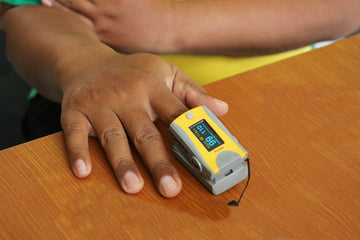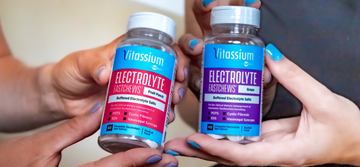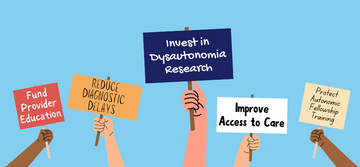What is Inappropriate Sinus Tachycardia and How is it Different From Postural Orthostatic Tachycardia Syndrome?
Mar 29, 2023

You may have heard of POTS, but have you heard of a more rare form of dysautonomia called IST?
Heart palpitations, dizziness, lightheadedness, and fatigue can all be symptoms of the common form of the autonomic nervous system disorder, Postural Orthostatic Tachycardia Syndrome (POTS). However, they can also be signs of other disorders that affect the autonomic nervous system, like the lesser known Inappropriate Sinus Tachycardia (IST). Although IST can cause similar symptoms, this complex chronic condition needs to be correctly diagnosed in order to be treated in the right way.
What is Inappropriate Sinus Tachycardia (IST)?
Inappropriate sinus tachycardia, also known as IST, is a rare, chronic condition that causes a resting heart rate of at least 100 BPM or an average heart rate of at least 90 BPM over a 24 hour period.
People with IST may have a high heart rate all the time, when triggered by minimal activity, or both. Sinus tachycardia occurs when the heart beats too fast but at a normal rhythm, meaning that your heart is beating evenly without any jumps or skips.
Other symptoms include heart palpitations, dizziness, lightheadedness, chest pain, shortness of breath, weakness, exercise intolerance, headaches, fatigue, and, in rare cases, fainting. Some people with IST are asymptomatic while others experience debilitating symptoms that significantly reduce quality of life.
Who can get IST?
Inappropriate Sinus Tachycardia affects an estimated 1.2% of the population, although it is believed to be underdiagnosed. IST mostly affects young women between the ages of 15 and 45 years old. Women are four times more likely to be diagnosed with IST than men.
Is IST “just” anxiety?
It’s important to note that Inappropriate Sinus Tachycardia is NOT a psychological condition. Receiving an IST diagnosis can be difficult as it is often misdiagnosed as anxiety or depression because of overlapping symptoms. Living with IST can be challenging at times, making mental health support an important aspect of care for some people. However, treating mental health conditions will not fix the underlying cause of IST.
When asked about her diagnosis journey with IST, Lauren Mackey, Digital Media and Community Specialist at Vitassium, shared:
“I had a virus in 2017 that I never really recovered from. I began to develop a wide array of symptoms, including an extremely high heart rate. Unfortunately, I visited the emergency room twice, but was told it was anxiety and dismissed. In 2019, I saw a cardiologist who, after ruling out POTS and other possible explanations for my symptoms, diagnosed me with IST.”
What causes IST?
Causes of Inappropriate Sinus Tachycardia are not well understood, but it is believed that problems with the autonomic nervous system (the system that regulates your heart rate and other “automatic” functions like digestion) is a primary underlying factor. This can cause a hypersensitivity to the mechanisms that cause signals to the cardiovascular system, a disruption to the heart’s natural pacemaker, or changes in the way the nervous responds to stimuli. Additionally, viral illnesses like COVID-19 have been linked with the onset of IST.
What is the Difference Between Inappropriate Sinus Tachycardia (IST) and Postural Orthostatic Tachycardia Syndrome (POTS)?
Although Inappropriate Sinus Tachycardia and Postural Orthostatic Tachycardia Syndrome (POTS) have some overlapping symptoms, you can be diagnosed with both. Eleven percent of people with POTS report also being diagnosed with IST.
As mentioned previously, the diagnostic criteria for IST is a resting heart rate of at least 100 BPM or an average heart rate of at least 90 BPM over a 24 hour period. In contrast, the diagnostic criteria for POTS is a sustained increase in heart rate of at least 30 BPM within 10 minutes of standing.
Someone with POTS may have a normal heart rate when lying down or sleeping, while someone with IST may still experience a high heart rate at rest. If a person has both IST and POTS, they likely have a baseline heart rate that is greater than 100 beats per minute, and their heart rate will substantially increase from their baseline when in the upright position.
Another form of dysautonomia that may be confused with IST is orthostatic hypotension (OI). Individuals with OI will experience an exaggerated drop in blood pressure upon sitting or standing, causing many similar symptoms, including a rapid heart rate.
How is Inappropriate Sinus Tachycardia (IST) Diagnosed?
IST is a diagnosis of exclusion, meaning your healthcare provider will likely order tests to rule out other causes of your symptoms, like certain medications and other chronic conditions like anemia, hyperthyroidism, and certain cardiac conditions. These tests may include blood work, an electrocardiogram, an echocardiogram, a 24 hour (or longer) Holter monitor, a chest x-ray, or a tilt table test.
How is Inappropriate Sinus Tachycardia (IST) Treated?
Unfortunately, Inappropriate Sinus Tachycardia is not well understood and there is little research available on effective treatments. Successfully lowering heart rate does not always reduce other symptoms caused by IST. You should speak with your provider about treatment options that may help manage your symptoms, including:
- Increasing fluid and salt intake: Dehydration can worsen IST symptoms, so making sure you have proper hydration is key. Increasing fluid intake while consuming electrolytes like Vitassium are a great way to stay hydrated. Speak with your provider about how much fluids and electrolytes you should consume daily.
- Avoiding stimulants and alcohol: Nicotine, marijuana, alcohol, and coffee can all worsen IST symptoms. Try treating yourself to a decaf coffee or an herbal tea instead.
- Avoiding the heat: Higher body temperatures can also worsen IST symptoms. Try to stay indoors during heat waves with air conditioning and avoid hot tubs and saunas.
- Wearing compression: Wearing compression socks or pantyhose may improve IST symptoms.
- Exercising: While it may sound counterintuitive, regular exercise and yoga can help strengthen how your vagus nerve works, one of the nerves that helps regulate the autonomic nervous system, and prevent deconditioning.
- Taking certain medications: Your provider may recommend certain medications like beta blockers, calcium channel blockers, or Ividabrine, all of which work to lower your heart rate.
Lauren shared what tools that she uses to help manage her IST symptoms:
“One of the best management tools that has worked for me in the past was using a beta blocker. Now, I mainly manage my IST symptoms by avoiding my triggers. I try to eat small, lower carb meals throughout the day, stay hydrated, and avoid caffeine and excess heat (like hot showers). When I'm in a flare, I like to put my legs on a wedge pillow or against a wall to encourage blood flow back to my heart.”
Everyone living with IST is different, so management for IST is not a “one size fits all” solution. Often, it will take some trial and error with different lifestyle changes and medications to find the best fit to provide the most relief from symptoms.







